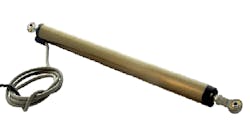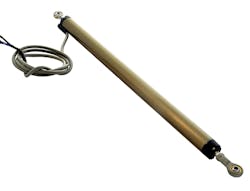True Cost of Ownership for Linear Position Sensors, Part 3
This file type includes high-resolution graphics and schematics when applicable.
The first two parts of this series have dealt with the types of position-sensor technologies commonly utilized in industry today, raising questions about which position-sensor specifications are most important to a particular application. Strengths and weaknesses, as well as relative unit cost, of sensors have been examined.
However, the cost of ownership goes far beyond just the sensor’s price. This final chapter of the three-part series is devoted to understanding the true cost of ownership (TCO) of the position sensor based on the cumulative effect of four distinct cost categories:
• Initial costs
These include procurement costs like purchase price and shipping and landing costs; administrative and sourcing costs; paid warranty extensions; the cost of spares or backup equipment; cost of any ancillary gear like mounting hardware, electrical cables, external signal conditioners, dc power supplies, and uninterruptible ac power supplies; the cost of measurement standards or related equipment for calibration or periodic recalibration that would be purchased and stored on site; and application-specific software that is needed to make the sensor-based system useful to the user.
• Installation costs
These include costs of in-house personnel or outside contractors to mount and calibrate the hardware in situ; construction costs associated with the installation; the cost of calibration equipment rental, if any; the cost of third-party QA certification if needed; the cost of operator training, whether on-site or at the sensor manufacturer, which then includes any travel expenses incurred; and the cost of documentation related to the installation, calibration procedures, and maintenance program.
• Maintenance costs
These costs include in-house personnel conducting preventative maintenance (PM) based on the sensor manufacturer’s recommendation; paid service contracts; and an in-house or third-party recalibration process, including a factory recalibration, based on an internal QA schedule for ISO 9001 or similar quality program compliance. Costs associated with sensor repair or replacement due to wear out or for an unanticipated failure are covered in the next category.
• Contingency costs
Projected costs from sensor failure/wear out attributable to unscheduled down time and production interruption; if no spare sensor is available, the lead time for a replacement (which contributes to the projected down-time cost), as well as the procurement cost and expedited shipping cost of the replacement sensor; and the projected costs to uninstall the failed sensor and install and calibrate the replacement sensor in situ by in-house personnel or a contractor.
Cost-Based Sensing-System Decisions
When and how some of the contingency costs come into play is partially determined by certain actions reflected in the initial cost section, like buying an extended warranty and/or purchasing a spare sensor. The fact that these contingency costs are only projected potential costs is no reason to downplay or ignore them. They play an important role in the risk assessment involved with the decision concerning which position sensor technology to choose for your system application.
For example, using contactless sensors with a good reliability history might make keeping a spare on hand an unnecessary expense, whereas purchasing an extended warranty and/or spare is probably a good idea for a position sensor with known wear-out susceptibility (e.g., a potentiometer). In a similar way, choosing a sensor with good long-term calibration stability minimizes the need for periodic recalibration. It can lengthen the interval before recalibration may be required, thereby reducing maintenance cost.
Although a sensor manufacturer may provide manuals and documentation for its product, there is a cost for documenting the installation itself, the calibration procedures, and the system’s PM program. This cost may easily be overlooked, but usually contributes significantly to the true cost of ownership.
One of the more difficult decisions in considering total cost is whether to use in-house personnel or an outside contractor to do the installation and calibration. The installation part of this question is relatively straightforward. However, the calibration decision depends on whether calibration equipment must be purchased or could be rented as needed, or whether an outside calibration contractor could provide the necessary calibration standards and equipment, thus obviating the need to purchase or rent this equipment.
Another cost that often lacks visibility is the training of maintenance personnel. Typically, this is not a significant expense with simple measuring systems, but can be quite important in more complex factory automation applications for position sensing. Of particular interest is the training of personnel, regarding a PM program, to keep the system operating without interruption from sensor-related issues. In many cases, a PM program is included in third-party service contracts for a system.
A key facet of operator training concerns interaction with application-specific software tailored to the sensing system. Ideally this training should be done on site by the software vendor, but sometimes it must be done at their location. With custom software, training operator(s) on site is strongly preferred.
Several of these cost factors are related to the measuring system in general terms, but the choice of position-sensor technology often has a significant bearing on the system’s actual cost. Therefore, with a little study, the cost effects of choosing a particular sensor can usually be quantified.
Quantifying True Cost of a Sensing System
For a simple position measuring system, it is easy to identify the direct costs of the system. However, some latent expenses will still fall into one of the four categories noted above, and ought to be included in the project budget.
Typically, the budgeting for a simple sensing system is done on an ad hoc basis merely by adding a sensor’s purchase cost and any ancillary equipment costs, without considering the related costs. Clearly, this approach does not show the total costs of the sensing-system installation. A better budgeting process would be to examine the various costs exposed in the four cost categories listed above and compile a list of identifiable costs and expenses to be totalized as true cost.
For a more complex system, a careful examination of the various costs—in particular, a risk analysis pertaining to possible contingencies—can not only help in developing a more careful budgeting process, but also head off problems resulting from unforeseen future expenses. As noted above, compiling a list of identifiable costs and expenses based on the four cost categories will once again aid in arriving at a true cost.
For each company or user putting a measuring system together, the true expenses or costs attributable to the various actions identified in the four cost categories above will normally vary based on local labor costs, logistics expenses, engineering rates, and management priorities, in addition to the direct costs. Thus, there is no universal chart or spreadsheet to use as a reference cost guide.
Engineers tasked with developing a budget for a sensor-based measuring system often can obtain helpful guidance regarding labor rates and other expenses from the company’s cost accounting personnel. And if only limited ability exists to judge how much effort is required for a sensor installation or calibration, it is reasonable to get an estimate or quotation from a third party with experience in performing such tasks.
Regardless of how the true cost of ownership (TCO) is obtained, that information is very important when trying to select the appropriate position sensor technology for the measuring system. However, some companies designate portions of the costs from an accounting point of view as either expenses or capital investments. If this approach is being utilized by the cost accounting function of the company, it becomes necessary to separate the costs into different categories with different timelines and weightings of the value of each cost element.
The tables in this article, which are representative of those in the Cost Evaluation Worksheet, can make it easier for users to evaluate the total effect of the various costs that could be applied to the position measuring system. Users can use the budgetary value scales associated with different types of sensors obtained from the tables shown in “True Cost of Ownership for Linear Position Sensors, Part 2,” together with the costs determined above and any projected timelines for when these costs are likely to be incurred.
The priorities and timelines shown are based on typical position measuring systems, but they can be adjusted to suit the measuring system application. They serve primarily to focus user attention on the most significant cost drivers, although some application-specific costs cannot easily be prioritized.
Harold G. Schaevitz is CEO and president of Alliance Sensors Group, a division of H.G. Schaevitz, LLC.
Looking for parts? Go to SourceESB.
This file type includes high-resolution graphics and schematics when applicable.






